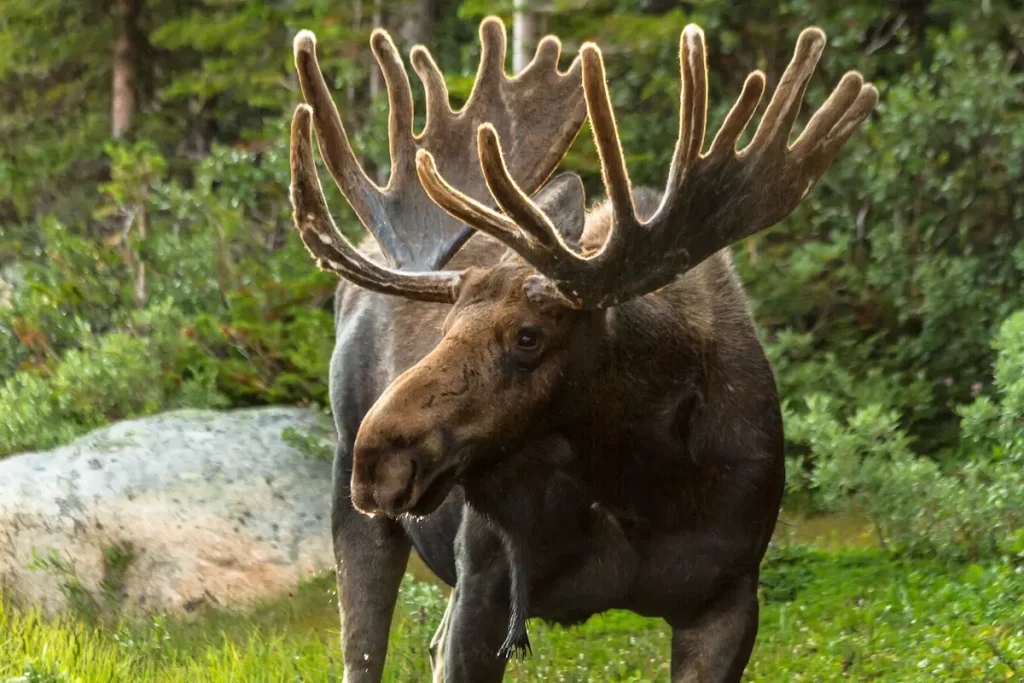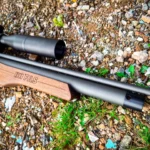Ever wondered how big is a moose compared to a human? Adult Moose usually measure up to 9 feet (2.8 meters) in terms of body length. Compared to a human, the average moose has a much bigger body overall, while also having a total body mass that is in the range of ten times that of a person at the same height.
A common sight in the colder regions of North America, moose are generally friendly creatures that pose little of a threat when approached. They’re known for their distinctive calls, deer-like antlers, and their bulbous noses that make them easy to tell apart from deer or elk.
But how big can a moose get, compared to a human?
Moose are the biggest representatives of the deer family, and a single look at one will tell you why. Larger than any horse, deer, or other hoofed animals, the moose towers above most mammals including us humans. If you want to know more fascinating facts about moose and their impressive bodies, feel free to take a look at our quick fact sheet below!

Related Reading: Do Moose Come Out in the Rain?
Table of Contents
How Tall is a Moose?
While it is easy to see that moose are incredibly massive animals, and their bodies can easily dwarf those of us human beings, there is the question of how tall moose really are, not just how big overall. Being four-hoofed animals that never walk upright, the total body dimensions of a moose are a bit misleading when it comes to visualizing just how large a moose looks when put next to a human.
Adult moose measure about 6 to 7 feet (1.8 to 2.2 meters) in height when measured at the shoulder. However, when the head and antlers are taken into account and the moose stands tall, this figure can eclipse 10 feet (3 meters).
As you can tell, the measurement of a moose’s height paints a different picture than the sole body length numbers alone – however, it should still be quite clear to see that moose are gigantic animals, and even smaller specimens will have us, humans, walking in their shadows due to their sheer mass and size.
How Big Can a Moose Get?
Over the course of a moose’s life cycle, their bodies change and develop quite radically, just like ours. Therefore, how big a moose can get depends on a few factors.We’ve laid everything out in the quick overview below. It should give you everything you need to know about the dimensions of a moose.
- First note that moose exhibit sexual dimorphism, i.e. females are of different size and appearance than males. A female moose will not grow antlers, and is on average about 60-70% the body mass of a comparable male
- There are a few recognized subspecies of moose, the largest of which is the Alaskan moose. The so-called Taiga moose, which is common across Central Europe, Russia, and parts of Kazakhstan, is noticeably smaller
- As moose age, their bodies grow larger and stronger. Male moose start growing antlers after about a year of age, and they renew them after every mating season. At their peak, the antlers alone can be over 6 feet (1.8 meters) long, somewhat shorter in the case of Eurasian moose
- Moose calves are about the same size as horse calves, but they grow very quickly and reach adult size after a year
- The biggest moose ever confirmed was a male Alaskan moose shot in 1897 – it measured 7.6 feet (230 centimeters) tall at the shoulders and weighed 1,800 pounds (816 kilograms)
Why Are Moose So Big?
While it is obvious that moose are some of the largest herbivores found in North America and Eurasia, the less obvious fact is the answer to the question of why their bodies are as massive as they are.
The truth is that moose need to be so large in order to properly survive in their natural habitat. The cold temperatures and harsh seasons that moose often experience in Alaska and Siberia have effected great evolutionary pressure on these animals – and it shows.
Moose have many tricks up their sleeves in order to cope with their home climate. For example, their many hairs are hollow on the inside, which helps them insulate for added warmth.
The incredible weight that moose pack on is also no coincidence – large volumes of fat storage provides another way to weather the freezing temperatures outside, so moose like to keep themselves well-fed.
And in turn, this excessive body weight needs to be supported by strong limbs and muscles – which is why the body of a moose needs to reach its uniquely humongous dimensions in order for these animals to thrive.
In fact, when moose are introduced to warmer climates (as is unfortunately the case more and more often these days as areas historically populated by moose undergo climate change), their bodies suffer greatly. They lose weight, experience chronic stress, and female moose will also develop fertility issues.
All in all, the short answer for why moose are so big is that they have evolved more so than almost any other four-hoofed herbivore to survive exceptionally well in the cold.
No wonder, then, that there is only one animal that shares the moose’s habitat and can rival it in size – the bison, another mammal whose gigantic body is mostly the result of evolutionary pressures intended to make it easier to survive freezing winters.
Related Reading: Can You Ride a Moose? Has It Ever Been Done?
How Big Are Moose Antlers?
The antlers are easily the most recognizable aspect of the moose’s appearance. However, just like deer, moose “renew” their antlers every season, and with each passing year the antlers grow longer, taller, and more intricate. It should also be noted that female moose (cows) never grow antlers.
The antlers of an adult male moose are typically up to 6 feet (1.8 meters) long end-to-end. The moose with the longest antlers are by far the Alaskan variety, while Eurasian moose tend to display slightly shorter specimens.
The antlers of a moose can add significantly to the animal’s overall size, though most formal measurements of moose are based on the height measured at the shoulders.
Why Are Moose Antlers So Big?
Though they add a lot of distinctiveness to the visual appearance of a moose, it is a question worth asking why moose grow their antlers to such an impressive size to begin with.
The antlers of the moose are used for display purposes, indicating a male’s sexual prowess and overall health and strength. If multiple males compete over a single female, they will actually use their antlers to fight. The victor is then generally taken to have the stronger antlers, and by extension the stronger, healthier body with the superior genes. Therefore, natural selection has led to most moose growing impressively large, intricately-shaped antlers.
The moose’s antlers might not be as significant to the animal’s daily lifestyle as most other parts of their bodies – however, when mating season strikes, their antlers are their number one tool of choice in order to attract the perfect mate. And in cases of rivalry between male moose, they can serve as potent weapons and displays of strength!
Are Moose Dangerous?
Now that you know all the basic facts about the size of the average moose you might encounter in the wild, you might be a bit worried that these large animals with their weapon-like antlers could pose a threat to your or your loved ones. But is it true that moose are dangerous animals?
While moose are certainly massive and strong enough to cause serious damage to people and their property, they are not very aggressive animals. Generally speaking, it is hard to provoke them, and incidents where moose attack humans have been incredibly rare throughout history.
The moose is not an animal that will charge or attack a random bystander for no good reason. As long as you keep your distance and do not make any moves that could be considered threatening, you should be perfectly safe.
If a moose does charge you, it is also a good idea to flee and not try to do anything to calm it or go any closer – moose can run at 35 mph (56 kph), and they generally only let go once they realize that their aggressor has given up.
Continue Reading: How Long Is Moose Meat Good in the Freezer? [ANSWERED]











































![Air gun 101: The differences between .177 & .22 – Which jobs they do best ? [Infographic]](https://airgunmaniac.com/wp-content/uploads/2024/11/1773-150x150.jpeg)